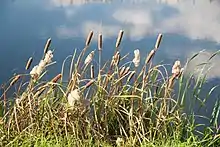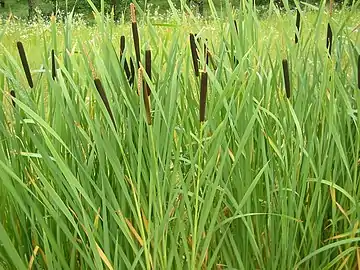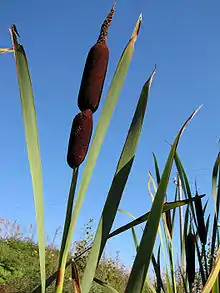Typha latifolia
Typha latifolia, better known as broadleaf cattail,[4] is a perennial herbaceous plant in the genus Typha. It is found as a native plant species in North and South America, Eurasia, and Africa.
| Typha latifolia | |
|---|---|
 | |
| Scientific classification | |
| Kingdom: | Plantae |
| Clade: | Tracheophytes |
| Clade: | Angiosperms |
| Clade: | Monocots |
| Clade: | Commelinids |
| Order: | Poales |
| Family: | Typhaceae |
| Genus: | Typha |
| Species: | T. latifolia |
| Binomial name | |
| Typha latifolia | |
| Synonyms[2][3] | |
|
Synonyms list
| |
Names
Typha latifolia has many other names: broadleaf cattail, Bulrush, common bulrush, common cattail, cat-o'-nine-tails, great reedmace, cooper's reed, cumbungi.
Description
Typha latifolia grows 1.5 to 3 metres (5 to 10 feet) high[5] and it has leaves 2–4 centimetres (3⁄4–1+1⁄2 inches) broad. It will generally grow from 0.75 to 1 m (2 to 3 ft) of water depth.
The plant is topped with a flower or fruit cluster in a cigar shape.[5]


_stem_cross_section%252C_Arnhem%252C_the_Netherlands.JPG.webp) Cross section of plant's pseudostem, formed of overlapping leaf bases
Cross section of plant's pseudostem, formed of overlapping leaf bases Flower spikes in Lappeenranta, Finland
Flower spikes in Lappeenranta, Finland Mature male flower spike above immature female flower spike
Mature male flower spike above immature female flower spike Flower spike going to seed
Flower spike going to seed
Distribution and habitat
It is found as a native plant species in North and South America, Eurasia, and Africa.[6] In Canada, broadleaf cattail occurs in all provinces and also in the Yukon and Northwest Territories, and in the United States, it is native to all states except Hawaii.[7][8] It is an introduced and invasive species, and is considered a noxious weed in Australia and Hawaii.[9] It has been reported in Indonesia, Malaysia, New Zealand, Papua New Guinea, and the Philippines. It is referred to as Soli-soli in the Philippines.[6]
The species has been found in a variety of climates, including tropical, subtropical, southern and northern temperate, humid coastal, and dry continental.[8] It is found at elevations from sea level to 2,300 metres (7,500 ft).
T. latifolia is an "obligate wetland" species, meaning that it is always found in or near water.[10] The species generally grows in flooded areas where the water depth does not exceed 0.8 m (2+1⁄2 ft),[11] but has also been reported growing in floating mats in slightly deeper water.[8] It grows mostly in fresh water but also occurs in slightly brackish marshes.[10] The species can displace other species native to salt marshes upon reduction in salinity. Under such conditions the plant may be considered aggressive since it interferes with preservation of the salt marsh habitat.[10][12]
T. latifolia shares its range with other related species, and hybridizes with Typha angustifolia, narrow-leaf cattail, to form Typha × glauca (T. angustifolia × T. latifolia), white cattail.[8] Common cattail is usually found in shallower water than narrow-leaf cattail.
Uses
Traditionally, the plant has been a part of certain indigenous cultures of British Columbia, as a source of food, medicine, and for other uses. The rhizomes are edible after cooking and removing the skin, while peeled stems and leaf bases can be eaten raw or cooked. The young flower spikes, young shoots, and sprouts at the end of the rootstocks are edible as well.[13][14][15] The pollen from the mature cones can be used as a flavoring.[16] The starchy rootstalks are ground into meal by Native Americans.[14]
It is not advisable to eat specimens deriving from polluted water as it absorbs pollutants and in fact is used as a bioremediator. Specimens with a very bitter or spicy taste should not be eaten.[17]
In Greece, the plant is used in a dried form for traditional chair making, namely in the woven seat of the chair. To prepare the material, the plant is collected in the summer and left to dry for 40-50 days.
In San Francisco, a town in the Pacijan Island of the Camotes Islands of Cebu, Philippines, the plant, known by the name Soli-soli, is used as a type of weaving fiber and/or material in making mats, bags, hats, and other organic accessories and ornaments. Soli-soli weaving is considered as one of the main livelihoods of the townspeople, showcasing the local crafts of the San Franciscohanons, as well as offering a viable outlet for cultural expression and eco-tourism. The town even celebrates the overabundance of this plant in the island and the weaving industry through the Soli-soli Festival, a festival of thanksgiving dedicated to St. Joseph, the patron saint of the town. The festival is celebrated around the 19th of March, the solemnity of St. Joseph, the Spouse of Mary. The townspeople incorporate the plant in their festival costumes, oftentimes wearing outfits made completely from woven Soli-soli.
References
- Lansdown, R.V. (2017). "Typha latifolia". IUCN Red List of Threatened Species. 2017: e.T164165A84300723. doi:10.2305/IUCN.UK.2017-1.RLTS.T164165A84300723.en. Retrieved 12 November 2021.
- Tropicos, Typha latifolia
- The Plant List, Typha latifolia
- USDA, NRCS (n.d.). "Typha latifolia". The PLANTS Database (plants.usda.gov). Greensboro, North Carolina: National Plant Data Team. Retrieved 12 December 2015.
- "Cattails (Typha spp.)". University of California Agriculture & Natural Resources Statewide Integrated pest Management Program. Retrieved 2023-06-10.
- "Typha latifolia (aquatic plant)", Global Invasive Species Database. Retrieved 2011-02-21.
- Flora of North America vol 22 p 282.
- "Typha latifolia, U.S. Forest Service Fire Effects Information Database", U.S. Forest Service. Retrieved 2011-02-20
- "Typha latifolia (Typhaceae) Species description or overview", Hawaiian Ecosystems at Risk project (HEAR). Retrieved 2011-02-21.
- "USDA Plant Guide: Typha latifolia", United States Department of Agriculture. Retrieved 2011-02-20.
- "Broadleaf Cattail", Utah State University Cooperative Extension. Retrieved 2011-02-20.
- "Can Native Plants be Invasive?".
- Turner, Nancy J. Food Plants of Interior First Peoples (Victoria: UBC Press, 1997) ISBN 0-7748-0606-0
- Niering, William A.; Olmstead, Nancy C. (1985) [1979]. The Audubon Society Field Guide to North American Wildflowers, Eastern Region. Knopf. p. 810. ISBN 0-394-50432-1.
- Elias, Thomas S.; Dykeman, Peter A. (2009) [1982]. Edible Wild Plants: A North American Field Guide to Over 200 Natural Foods. New York: Sterling. p. 69. ISBN 978-1-4027-6715-9. OCLC 244766414.
- Benoliel, Doug (2011). Northwest Foraging: The Classic Guide to Edible Plants of the Pacific Northwest (Rev. and updated ed.). Seattle, WA: Skipstone. p. 61. ISBN 978-1-59485-366-1. OCLC 668195076.
- YouTube - Wild Living with Sunny: episode 4 Video describing collection and cooking of common cattail.
External links
- ROOK description
- Edibility of Cattail – Edible parts and identification
- U. of Michigan-Dearborn: Ethnobotany
